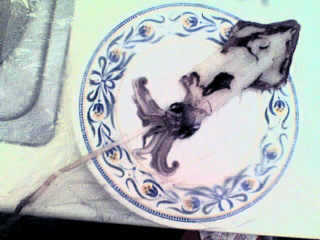
A Study of the Common Squid:
LOLIGO VULGARIS
by David Christmass © August 2009
Who among us could fail to pity the humble sick Squid at the fish and chip shop, perhaps at one time, an aged octogenarian, but now battered and baked, isolated and estranged from its brothers and sisters of the sea, with its humble remains, callously discarded, cut away, and estranged from the Calamari of the hot shelf: a Mantle to the dust bin alone? Who among us could fail to yield even, to the humble prayers of its bald fontanelles, amongst the ice packs of the supermarket fish monger, prayers for liberty, and for freedom, and prayers to realize its aspirations of reincarnation, within some kind of heavenly host, or holy ghost of hydration?
But, think again, and who among us could forget the aged Sea dog tales from the reportage of sailors and fishermen, in stories telling of these strange and unwieldy beasts: the wild tales of Denis De Montfort, and Victor Hugo; tales of Sea serpents and monsters and of an Underworld, all beguiling; tales of Sea monsters overcoming stern, sail, and seamen, in divers ways, and in one foul swoop?
The Common squid is an easy sight to oversee, there it rests: either in the supermarket, or stilled, on the sandy, mottled coral bed of the oceans floor, folded fore tentacles beneath its Mantle: with its omnipotent and omniscient eyes of almost Omni lateral vision, nothing passes overhead, without its tacit consent at rest, and its wholesome innocence preoccupied in form and status. There rests, a flying fortress of the sea, awaiting, just that chance moment to scramble from its haven: for many Squid, like Octopi, are not in any way akin to any normative features of the other fishes of their habitat: they are the Kings and Queens of their underwater Nemesis. Such Cephalopoda are gentle drifters of the oceans spheres at peace; the manifestation of the Molluscs of their former selves, but yet one of the most formidable forces to any who dare to disrupt or breech their territory on attack.
From the shallowest flights of the superficial Flying squid, like the Pelagic squid: Ommastrephes bartrami, which has a capacity to shoot out of the water in rough weather; even sometimes, onto the decks of ships, in some kind of cataclysmic act of self sacrifice to Apollo, to the far distant; deeper; darker oceans; and their compatriots in the taxonomy of the Cephalopoda: the 50m long Architeuthis, the rule of Squid is ever present about us. But it is these, the Gigantic squid, who exist as the massive monopolisers of their own domain and time; it is these, which have a capacity to appear from no where, and which again, can illusively vanish to a place, one knows not where: they are sloans of flight and sight; slothfulness and ignorance are never theirs. And yet, the mere sight of these fearsome creatures of the night sea, installs fear in both man, and fish alike. Only the princely Whales, and Cetaceans, like the Dolphin, have a capacity to challenge their awesome powers, as they dart towards their prey like torpedoes, and are thus spared the awesome tyrannical rule of the Octopus and Squid: the cats claw of the ocean bed.
But let us look at the anatomy of the Squid, Loligo vulgaris, to discover, what it is that grants these remarkable creatures, their esteemed status of fearsomeness in their priestly school.
Loligo vulgaris (Before Lunch)

Fig. 1.
Above is the complete outstretched form of the Common squid. Several of the creatures formidable features are very apparent from the exterior.
The highest part of the creature comprises of a Mantle, under which is suspended the anterior parts of the main body together with its posterior tentacles. At the top right of the picture, flanking the Mantle and equidistant about it, are two fins. The two fins provide the Squid with a stability and guidance while in flight. Some might think it apparent, from the form of the creature, that it floats in the sea like rather like a balloon, but in truth, the orientation of the Squid, is almost always, at some horizontal position, and the fins form the topmost part of the body, and are located at its anterior end.
The Mantle is made up of a flexible cartilage, which can be constricted, granting the Common squid its means of motivation forwards by a simple process water jet propulsion. What fun it must be to dance about the skies of the ocean sea, and in fear of nothing?
The main body of the Squid is suspended from the Mantle, as we shall see. Eyes are located either side of the body granting it the capacity to observe its environment in entirety through almost 360 degrees: there is no escape from this beast once it has sighted its victim: it is its own best policeman of its domain and territory.
The main body of the Squid, also houses its brain, and its central nervous system. It is the extraordinary physical size of the eyes which grant the Squid an unusually acute awareness of its surroundings, but also, the centralized locality of brain in the mid rift of the body, ensures that its physical responses are extremely swift. The relative correlation of eyes and brain, in physical size, tends to support that the Squid is not only acutely aware of its environment, but also extremely intelligent.
But perhaps, what makes the Squid an even more formidable challenger to its prey, is the placement of its tentacles about its main trunk: the immediate locality of its peripheral nervous structure about the main trunk, and so close to its brain, grants the Squid, extremely fast reaction capacities. So it is both acute in observation, and in response. The Squid has eight tentacles, of full form, some greater than others. In addition to these, there exists, an extended tentacle called the Hectocotylus which the Squid wields at will, toward its prey, in a sweeping and curling motion, and opposite to this, there is a truncated projection, which might have formed an extra leg or at least some form of tail, at some earlier point in developmental cycle in the formation of the fish.
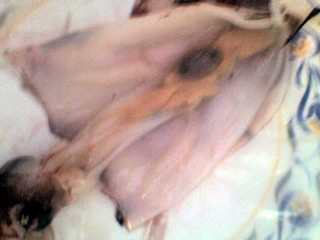
Fig. 2
The lateral section of the Mantle towards the anterior of the Squid shown above, allows for the exposure of the suspendatory parts of the Mantle cavity. The Mantle cavity houses the majority of life supporting internal organs of the creature. The main nervous system of the Squid is carried forwards, from the body and brain of the Head, and towards the anterior of Mantle end, where it acts to control the tissue structures of the Mantle. Parallel to this, exists the stomach, and digestive aspects of the creature, and its anus, and ink cloud sack.
Flanking the core of the Mantle, are two feint diamonds which are barely perceptible: the gills. The Mantle cavity can be constrained and the Head underneath withdrawn to the Mantle, thus protecting the internal organs from exposure to hazard: a motion which enhances further, its capacities of jet propulsion. A withdrawal of the Head, into the Mantle, also ensures, that hostile forces are kept well away from the Squid’s vital organs. And again, this increased flow of water through the Mantle cavity, ensures that the Squid is most efficiently supported with the necessary Oxygen, as it moves forward in the water is swift escape.
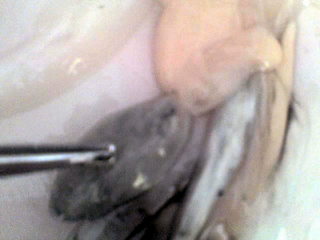
Fig. 3
This close up view of the innermost parts of the anterior of the Mantle shows the stomach of the Squid, and to the right, an ink sack containing the escape cloud Chromataphore, which provides an invisibility cloud of cover for the Squid in its flight.
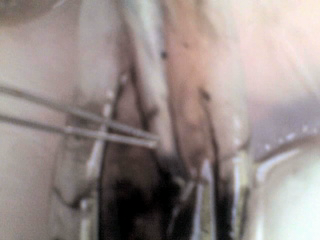
Fig. 4
Above is a close up view of the anal parts of the Squid. This is located on the underside of the Mantle and adjacent to the stomach. The anus serves two functions, the excretion of waste products, and the excretion of cloud dye from its storage sack, thus allowing the Squid to blind its opponents, become invisible to escape, and to also seize its prey.
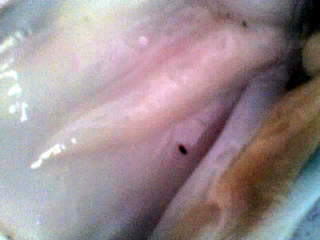
Fig. 5
A close up view of the left side of the Mantle shows the Squid’s gills.
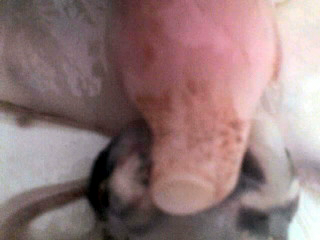
Fig. 6
Just above the Head, attached to the Mantle, is a conical flute: a Funnel Valve, which provides the Squid with a directional mobility, and allows the creature to turn and spin the orientation of its complete body, in horizontal rotational movements, extremely quickly.

Fig. 7
At the posterior end, the Squid is motivated by tentacles, which can also assist the Hectocotylus (shown underneath) by directing its prey or food, towards the posterior end of the Head, whereabouts the mouth is located. The Hectocotylus, also services as the mechanism of transfer of reproductive material, either from and to the genitalia of the Mantle, or from the Mantle to the mouth.

Fig. 8
Looking at the posterior end of the Squid, one can imagine the formidable problem in escaping the tentacles of the living creature. At the centre, one can perceive the opening to the mouth which houses the teeth or beak of the Squid.
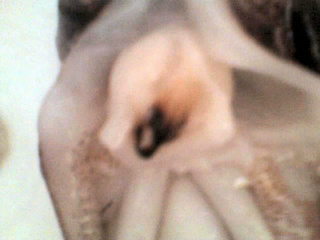
Fig. 9
A close up view of the mouth partition, reveals the beak of the Squid. In just running your finger along the edge of the beak, one is immediately aware of an extremely hard, bony, like substance, which rather resembles the beak of a parrot. It is razor sharp and formed in such a way that it is extremely strong in its constrictive nature.
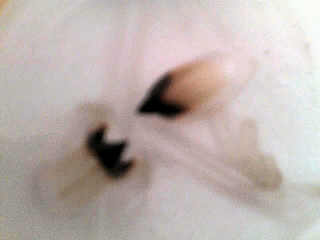
Fig. 10
A close up view of the beak held open by a small piece of plastic, to reveal the form and shape of the jaw bone structure. This is the only rigid material to the whole Squid. The top most jaw overlays the lower in such a way as its edges rest in the v like sections of the lower jaw. Clearly once gripped therein, there can be no escape.
If the close inspection of the basic anatomy of the Squid: Loligo vulgaris, has not been enough to convince you that this is a thoroughbred killer, through and through; consider its wily old nature, there resting on the sea bed, it has a remarkable capacity to alter its colour to disguise its locality among the corals rocks and sands, and while there, it never sleeps: the beast has no eyelids; at no point in its eventful life is this creature unaware of anything, or gives away its repository status.
And, at any point its mind considers it to be the right time to seek out its prey, it is motivated to action, shows a flood of ink, and swiftly enfolds its disoriented and unsuspecting target in its tentacles, and then takes an a snap with its beak which renders it target completely lifeless: who’d dare be its Valentine?
The next time you fancy a bit of seasonal Christmas festivities on the beach, consider the next rendition of Wesley’s carol, “Hark the herald angel sings”, or to give it etymological Pagan title, “Hark how all the welkin ring”, or hear of someone carping out at the London School of Economics, “Where did all the Loli go?” spare a thought for the humble Common Squid: that vivid artisan and decorator of all Christmas trees down under.
You might not be the only keen observant of pond life activities, and there might well be, another keen amateur microscopist, making its study of atmospheric life, through a looking glass, you never quite suspected.
Comments to the author, David Christmass are welcomed.
Microscopy UK FrontPage
Micscape
Magazine
Article
Library
Published in the February 2010 edition of Micscape Magazine.
Please report any Web problems or offer general comments to the Micscape Editor .
Micscape is the on-line monthly magazine of the Microscopy UK website at Microscopy-UK .
© Onview.net Ltd, Microscopy-UK, and all contributors 1995 onwards. All rights reserved. Main site is at www.microscopy-uk.org.uk with full mirror at www.microscopy-uk.net .